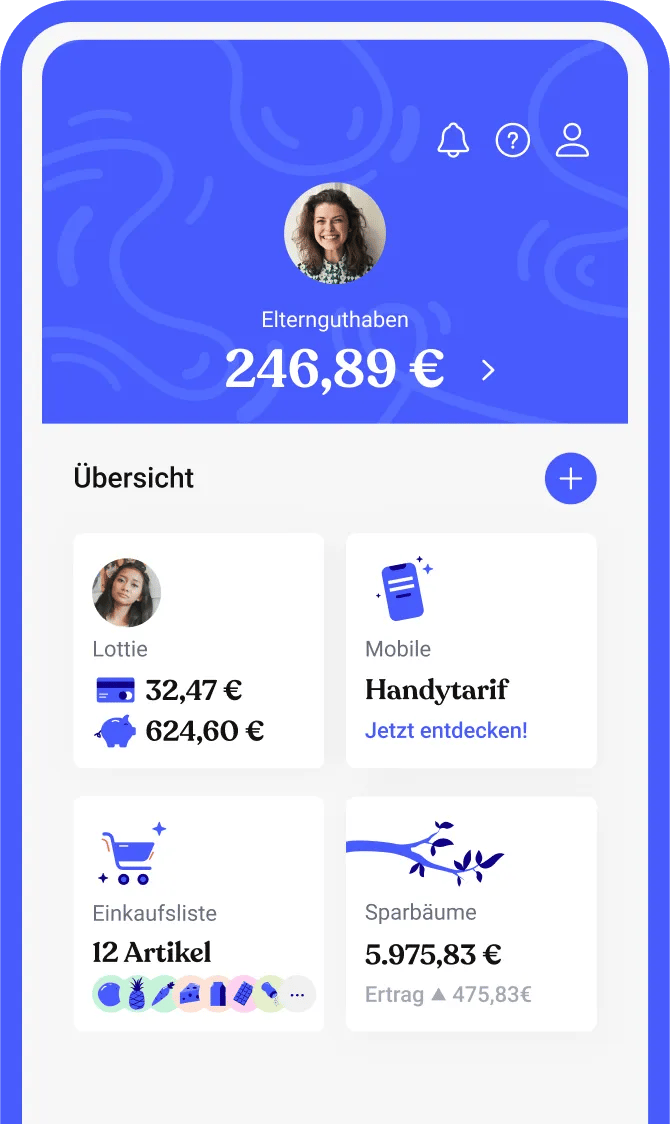Why is pocket money so important anyway?
pocket money is important for kids. It helps them to understand the value of money and to recognize that savings must also be made in response to big wishes. Children can only allocate their own pocket money correctly and realize that they can only spend it once and not pay anything indefinitely.
When children buy something with their pocket money, it is gone afterwards. It is therefore all the more important to make a fixed allocation and allocation of money at a fixed rhythm. If the children simply receive money when they ask mom or dad, there is no connection to the value behind it. With their first money of their own, children can already consume between and save differentiate. It is a first learning program for managing money that parents should definitely provide to their children.
If you want
Current study: Money is not enough of an issue in families
According to a recent Forsa study, 41% of children of primary school age do not receive any pocket money. Experts are critical of this. 500 parents of children aged between 9 and 6 years were interviewed nationwide. The remaining parents, who pay out pocket money to their children, make the payout dependent on various factors. For some, age is decisive, for others the child's behavior or school grades. However, there is too little talk about money in families, especially with the children. It makes sense to talk about topics such as Pocket money table or to talk about the parents' income and how much of it is spent each month.
If you want
Pocket money recommendation — when does pocket money make sense for children?
For experts, school enrollment is the right time to pay out pocket money to children. The Pocket money table even provides for regular payment at the age of 4 to 5 years. However, by the time they start school at the latest, children have the necessary maturity to To learn how to manage money. The question of when pocket money can be paid depends on the child's personal development. Can it already understand the value of money? How well can it count already?
If your child can already understand the value of money from the age of 4 or 5, then it makes sense to pay out a small amount of pocket money from this age. In this way, the children learn to solve their first math problems in a playful way. How much this first small pocket money should be, plus the Pocket money table the appropriate recommendations.
If you want
Up to what age does the pocket money list go?
Just as you have to consider when your child will receive pocket money, there is also the question of up to what age you would like to pay it. However, this depends decisively on your child's situation. The pocket money table recommends a payout up to the age of 18. However, if your child is still in school at the age of 18 and has not yet started an education, it makes sense to continue paying out the allowance until it is financially independent.
If your child is in education with a fixed salary at the age of 16, you can stop paying out pocket money. By the way, there is no legal obligation to pay out pocket money. Pocket money aged 18 and over is no longer listed in the pocket money table. It is best to discuss individually with your child how you want to manage the pocket money situation from the beginning of the age of majority or from the start of a professional career.
If you want
The 2023 pocket money table: How much pocket money is useful?
The pocket money table is a guide for parents to decide how much pocket money they should give their children at what age. It gives recommendations for weekly and monthly allowance, depending on the age of the child. The pocket money table is based on the experience and assessments of experts and takes into account the different needs and expenses of children at different ages. The Federal Ministry of Family Affairs publishes these recommendations at regular intervals with the youth welfare offices. However, if you use this pocket money table as a guide, you should always remember that it is only a recommendation.
If you want
How much pocket money for children: The current recommendations
The current Pocket money table 2023 shows the recommended age for paying out pocket money, the recommended amount and at what interval the pocket money should be paid out. In this pocket money table, you will therefore find a rough guide as to how much pocket money should be paid with 8, how much pocket money should be paid with 10 and how much pocket money should also be paid with 18 according to the table.
If you want
The pocket money table for 4 to 9 year olds (weekly payout):
- 4 - 5 years: 0.5 - 1 euro
- 6 years: 1 to 1.50 euros
- 7 years: 1.5 to 2.00 Eur0
- 8 years: 2 to 2.50 euros
- 9 years: 2.50 to 3.00 euros
If you want
Pocket money for 10-year-olds should be paid monthly from this year of age. In this way, children learn to allocate their money over a longer period of time.
If you want
The pocket money table for 10-year-old to 18-year-old children (monthly payout):
If you want
If you want
The figures from the pocket money table are based on the expertise of the German Youth Institute and are only to be regarded as a recommendation. Depending on the financial framework of a family or the number of children living in the household, a lower payout below the recommendation of the pocket money table is just as possible. Parents should always talk openly about the topic with their children here. In the case of financially better off households, parents should not deviate significantly from the amounts recommended in the pocket money table. The desired learning effect only occurs when children also have to restrict themselves from time to time. This is not successful if they always have money at their disposal.
If you want
The parents' consistency is more important than the amount of pocket money
The parents' consistency is even more important than the question of how much pocket money should be according to the current pocket money table. They should stick to the arrangements and not “exceptionally” increase their pocket money or add anything if the money is not enough to buy the new stuffed animal.
However, here too, it always depends on individual agreements as to what pocket money has to be paid for. If, for example, your teenager wants to contribute to the expensive brand clothes with their own money, it makes perfect sense to increase the pocket money in return, in contrast to the pocket money table. If the money is not enough, children and young people should be given the opportunity to earn some extra money through various household activities.
Tip for parents living apart: If you live apart as parents, it is important that you agree on a fixed amount and that one parent does not pay more than the other. When determining the amounts, it is best to use the pocket money table.
If you want
What does the pocket money paragraph say?
Some parents are mistaken in believing that the pocket money paragraph is a legal basis for how much pocket money you have to pay your child. In fact, no one can dictate this to you, because the payment of pocket money is always voluntary. The pocket money table is also not binding and is only a basis for your decisions.
The pocket money paragraph relates to Section 110 of the Civil Code (BGB) in Germany. This paragraph allows minors to make purchases to a limited extent. This legal regulation on the legal capacity of minors is important as they have only limited legal capacity. Normally, minors can only carry out transactions effectively with the consent of their parents, such as buying a toy in a store. However, they have legal capacity to the extent that they can buy something when they can pay the amount of their pocket money. A new iPhone must therefore not be sold to a 10-year-old. Sellers can also roughly use the pocket money table as a guide.
The pocket money paragraph only applies to cash purchases and not to installment purchases. A minor may therefore not conclude a mobile phone contract without parental consent. Not even if he can pay the monthly costs with his pocket money according to the current pocket money table.
If you want
Pocket money as a means of pressure? Can quickly become dangerous!
Unfortunately, it is often common practice to use pocket money as punishment or as a means of pressure. If you use pocket money to encourage your child to behave in a certain way, it won't teach them how to handle money. It is the same with additional pocket money as a reward for positive behavior.
For example, contrary to the recommendation of the pocket money table, you give your child more money for better grades, this makes little sense in educational science. Because what happens if the child tries very hard and still doesn't get a better grade? In principle, children should be able to dispose of their assets reliably regardless of external circumstances. If the misconduct has nothing to do with pocket money, the pocket money should also not be used as punishment.
The situation is different if, for example, the child destroys something at home with his new ball. From an educational perspective, it then makes sense for the child to contribute his pocket money to the purchase of a new purchase.
If you want
Payment of pocket money — cash or to a current account?
It is best if the pocket money is always paid on a fixed date, for example every Saturday or on the 1st of the month. There are various ways to pay out pocket money.
- Withdraw pocket money in cash
For smaller children, it makes sense to give them the money in cash. They learn different calculation options in a playful way and recognize better that the money is also physically gone when they spend it. - Pocket money on a current account
Many banks now offer current accounts, which allow children and young people to store their money even with their own card. However, payments cannot usually be made with this card.
If you want
That is the advantage of the new pocket money card from Bling
The company Bling had its very own idea of how children could become even more independent when it comes to dealing with money. Bling has developed a special pocket money card that is available for children aged 7 and over. Parents can transfer their pocket money to it and children can even use it to pay in a shop. The whole thing is complete hedged and you have a full overview of your child's finances, set the rules and also the limits. Your child cannot incur debts with this card.
Teens can connect the card with their own app on their smartphone and thus get an even better insight into their income and expenses. In addition, they can - if you want - about various Household tasks To earn some more money. As a result, your child learns the value of work and that a little housekeeping doesn't just happen by itself. A task planner helps everyone get involved in the right places.
If you want
What should the children's pocket money be spent on?
You know this for sure: What the next big thing is for your child ends up in the trash can in your mind's eye. Fragile, flashing Chinese goods with no educational added value: You would love to forbid the purchase from the outset and motivate your child to invest in something “meaningful” instead.
The clear educational recommendation here is: If your child is to learn how to handle money, they must also be able to spend their pocket money freely - at least until they are teenagers. This is the only way children can learn how to save. For this reason, you should accept that your pocket money is spent on what you think are pointless things such as sweets or toys from the chewing gum machine.
Always talk to your child about what costs they will pay and what they can buy with their pocket money. Pocket money is not intended for clothing, school supplies, tickets or food. Parents should continue to bear these costs. On the other hand, unscheduled activities such as going to the cinema or visiting an amusement park with friends can of course be paid for with pocket money.

























